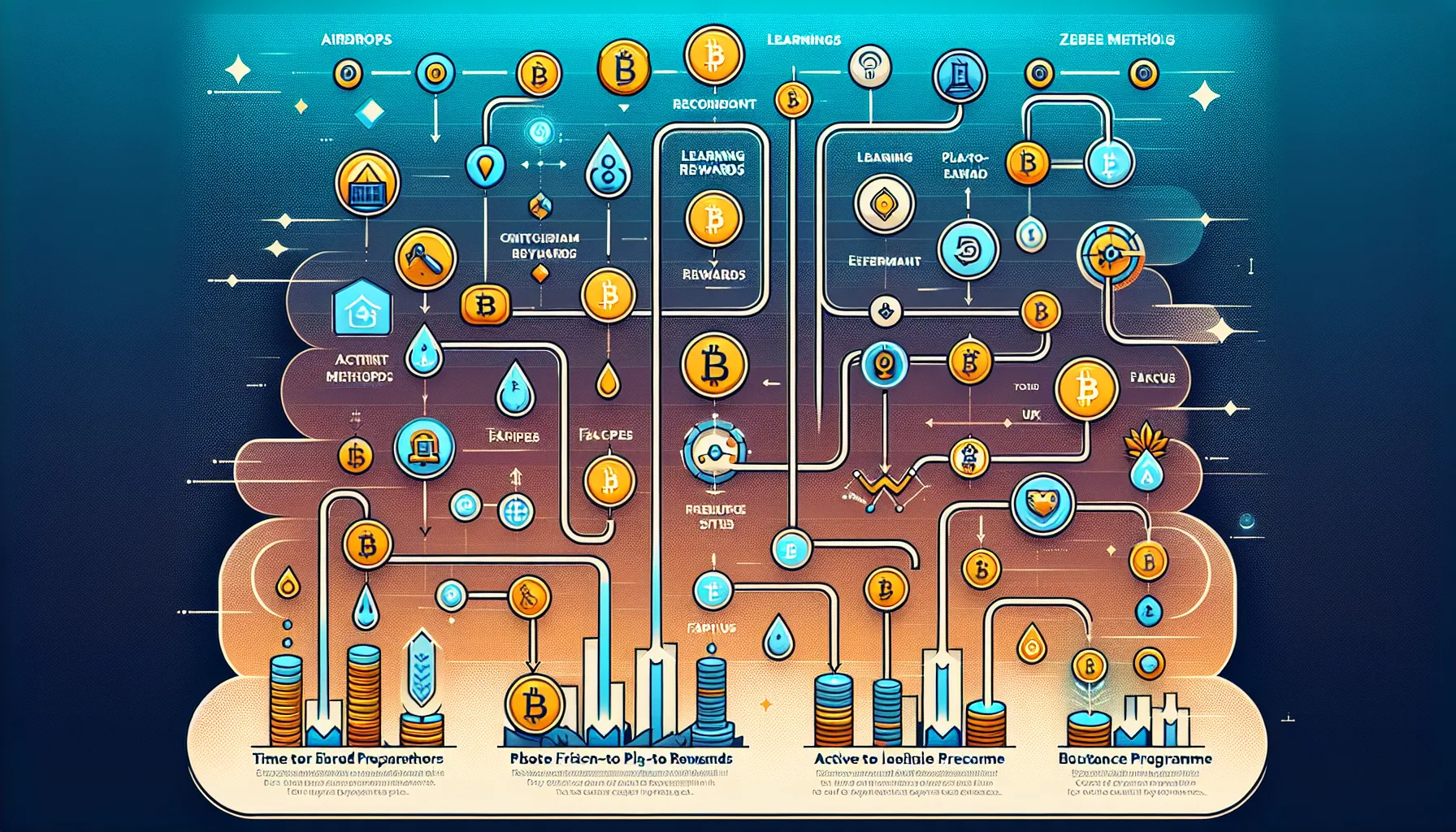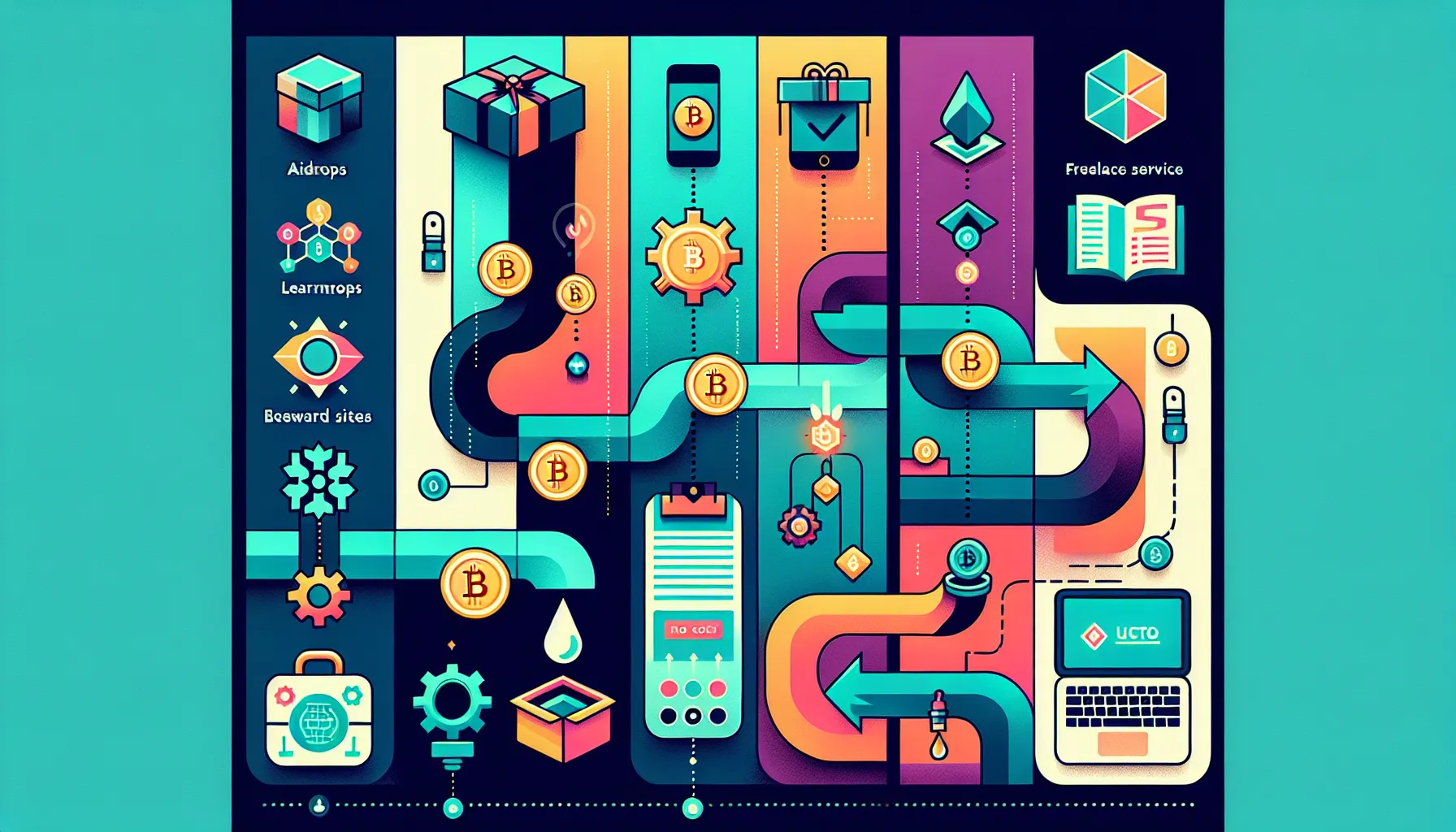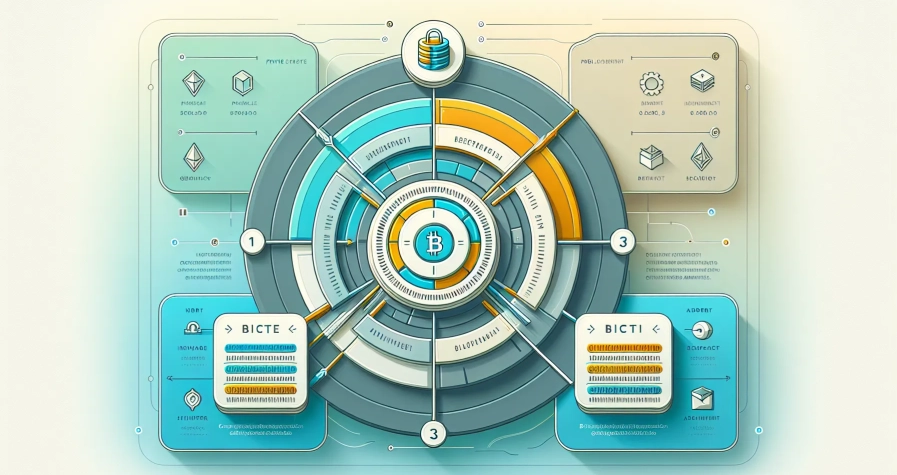Cryptocurrency has evolved far beyond being merely a speculative asset for investors with capital. For those without funds to purchase digital coins, a growing range of opportunities exists to earn crypto through time, skill, and effort rather than upfront cash. From educational platforms that reward learners to play-to-earn blockchain games, airdrops, and freelance gigs paid in digital tokens, the barrier to entry has never been lower.
These methods aren’t a shortcut to overnight riches, but they do provide genuine pathways for individuals to accumulate digital assets without opening their wallets. Whether someone’s curious about blockchain technology, eager to monetise their existing skills, or simply looking for an alternative to traditional earning models, free crypto earning is both accessible and practical. This article explores the full spectrum of ways to earn cryptocurrency without investing money, with clear guidance on how to identify legitimate opportunities and sidestep scams.
Key Takeaways
- You can earn crypto without investing money through airdrops, learn-and-earn programmes, play-to-earn games, faucets, and freelancing for digital token payments.
- Educational platforms like Coinbase Earn and Binance Learn and Earn reward users with free cryptocurrency for completing short courses and quizzes about blockchain technology.
- Play-to-earn blockchain games allow players to accumulate tradeable tokens and NFTs through gameplay, though sustainable tokenomics and security audits are essential factors to evaluate.
- Legitimate opportunities to earn crypto without investing never require private keys, seed phrases, or upfront payments—these are always red flags for scams.
- Freelancing for cryptocurrency payments offers higher earning potential than passive methods and provides faster international transactions with reduced fees.
- Diversifying across multiple earning methods, using dedicated wallets, and maintaining realistic expectations maximise your chances of safely accumulating digital assets over time.
Understanding Free Crypto Earning Methods

Free crypto earning methods allow individuals to acquire digital assets without any upfront capital. These strategies typically require a different type of investment: time, attention, skills, or effort. The landscape includes several established approaches, each with its own requirements and potential rewards.
Common methods include airdrops, where projects distribute free tokens to build awareness or reward early adopters, and learning rewards offered by major exchanges that pay users for completing educational content. Play-to-earn games have carved out a niche where players earn tradeable tokens or NFTs through gameplay. Crypto faucets dispense tiny amounts of cryptocurrency in exchange for completing simple tasks like viewing ads or solving captchas. Reward sites extend this concept, offering crypto payments for surveys, watching videos, or other micro-tasks.
Beyond passive methods, there are active earning routes: providing freelance services in exchange for crypto payments or participating in bounty programmes where projects compensate contributors for bug testing, content creation, or promotional work.
The common thread across all these methods is that they eliminate the need for initial financial outlay. But, realistic expectations matter. Earnings from faucets might be measured in fractions of a penny, whilst freelance crypto payments or successful participation in quality airdrops can yield more substantial returns. The key is choosing methods that align with one’s available time, skills, and tolerance for effort-to-reward ratios.
Earn Crypto Through Airdrops and Giveaways
Airdrops represent one of the most popular methods for acquiring free cryptocurrency. Projects distribute tokens to wallet addresses without requiring payment, typically as a marketing strategy to build awareness, encourage network decentralisation, or reward early community members. Some airdrops target users who previously interacted with specific protocols, whilst others are open to anyone willing to complete simple tasks like following social media accounts or joining Telegram groups.
Giveaways function similarly but often run during project launches or special promotional campaigns. Reputable projects occasionally host giveaways on platforms like Twitter or Discord to engage their communities and attract new users. The tokens distributed through airdrops can range from established cryptocurrencies to brand-new project tokens with uncertain futures.
Participation is usually straightforward: users provide their wallet address, complete specified tasks, and wait for tokens to arrive. Some airdrops are retroactive, rewarding users who’ve already engaged with a protocol before the announcement. Others require prospective participants to register in advance and fulfil certain criteria.
The appeal is obvious, free tokens that could potentially appreciate in value, but the landscape is littered with pitfalls that require careful navigation.
How to Find Legitimate Airdrops
Finding genuine airdrops amidst a sea of scams demands diligence. Legitimate opportunities typically come from projects with established reputations, transparent teams, and active development. Trusted crypto communities on platforms like Reddit, Discord, and specialised airdrop aggregator websites can serve as valuable filters, though even these sources require verification.
The golden rule: always confirm airdrop details through official project websites and verified social media accounts. Cross-reference information from multiple trusted sources before committing any action. Reputable projects will never ask for private keys, seed phrases, or wallet passwords. Any airdrop requesting such information is a scam, full stop.
Red flags include unrealistic promises (like guaranteed massive returns), poor grammar in official communications, pressure to act immediately, requests for upfront payments, or demands to send crypto to receive more. Legitimate airdrops don’t require users to deposit funds or share sensitive security credentials.
Using a separate wallet exclusively for airdrops adds another layer of security. This quarantine approach means even if something goes wrong, it won’t compromise holdings in primary wallets. Before participating, research the project’s whitepaper, check the development team’s credibility, and assess whether the project has genuine utility or is merely a token with no purpose beyond the airdrop itself.
Get Paid in Crypto for Learning
Educational platforms offered by major cryptocurrency exchanges have transformed learning about blockchain into a paid activity. Programmes like Coinbase Earn and Binance Learn and Earn allow users to watch short educational videos about specific cryptocurrencies or blockchain concepts, then complete simple quizzes to demonstrate understanding. Upon passing these quizzes, participants receive small amounts of the featured cryptocurrency directly into their exchange accounts.
The structure is deliberately accessible: videos rarely exceed a few minutes, questions are straightforward, and there’s typically no penalty for incorrect answers, users can simply retake the quiz. The crypto rewards are usually tokens from emerging or smaller-cap projects that partner with exchanges to increase awareness and adoption.
From the exchange’s perspective, these programmes serve multiple purposes: they educate users about the broader crypto ecosystem, increase engagement with the platform, and introduce traders to new tokens they might later purchase. For participants, it’s a risk-free way to build a small, diversified crypto portfolio whilst actually learning about blockchain technology, consensus mechanisms, decentralised finance, and specific project use cases.
Earnings per course typically range from a few pounds’ worth of crypto to occasionally higher amounts for more in-depth programmes. Whilst no one will retire on learn-and-earn rewards alone, the accumulated value over time, particularly if the tokens appreciate, can become meaningful. More importantly, the knowledge gained has intrinsic value for anyone looking to navigate the cryptocurrency space more confidently.
Availability of courses varies by region and platform, with new opportunities appearing regularly as exchanges partner with additional projects. Setting up alerts or regularly checking platform learning sections ensures users don’t miss new earning opportunities.
Play-to-Earn Games and Blockchain Gaming
Blockchain gaming has introduced economic models where players earn cryptocurrency or tradeable digital assets through gameplay. Unlike traditional games where in-game items hold no real-world value, play-to-earn (P2E) models built on blockchain technology allow players to own, trade, and sell items as NFTs or earn native tokens that can be exchanged for other cryptocurrencies.
Games like Axie Infinity pioneered this model, where players breed, battle, and trade creatures called Axies, earning tokens through victories and participation. Splinterlands offers a card-battler experience where skilled players earn rewards that can be converted to crypto. Gods Unchained, The Sandbox, and numerous other titles have built entire economies around player ownership and earning potential.
The mechanics vary considerably. Some games reward daily login bonuses or task completion with tokens. Others require strategic gameplay, with earnings tied to tournament performance or marketplace trading. Certain games allow players to stake in-game assets for passive income, whilst others reward content creation or land ownership within virtual worlds.
The P2E sector isn’t without challenges. Early models faced criticism for unsustainable token economics, where rewards outpaced genuine demand, eventually collapsing in value. Some games require initial purchases to start earning, though truly free-to-start options exist. Time investment can be substantial, some games demand daily engagement to maximise earnings, effectively becoming a second job.
Selecting Worthwhile Play-to-Earn Platforms
Choosing the right P2E platform requires research beyond surface-level marketing. Start by examining the project’s tokenomics, the economic model governing how tokens are created, distributed, and burned. Sustainable models balance player rewards with token demand, preventing inflationary collapse. Projects with deflationary mechanisms, utility beyond just earning (like governance or in-game functionality), and capped token supplies tend to maintain value better.
Smart contract audits are essential. Reputable projects undergo security audits by established firms to verify code integrity and protect against exploits. This information is typically available in project documentation or on the audit firm’s website. Games built on established blockchains with active developer communities generally offer more security than obscure platforms.
Community strength provides insight into longevity. Active Discord servers, engaged social media followings, and transparent communication from development teams signal healthy projects. Conversely, ghost towns on social media or teams that avoid addressing community concerns raise red flags.
Game quality matters too. A play-to-earn game that’s tedious or poorly designed won’t sustain a player base regardless of earning potential. Read reviews, watch gameplay videos, and if possible, test the game before committing significant time. Check whether the earning model is genuinely free-to-start or requires hidden investments to be competitive.
Finally, assess the project’s roadmap and whether the team delivers on promises. Established track records, regular updates, and achieved milestones indicate commitment. New projects with anonymous teams, vague roadmaps, or promises of guaranteed returns deserve extreme scepticism.
Earn Crypto Through Faucets and Reward Sites
Crypto faucets emerged as one of the earliest methods for distributing small amounts of cryptocurrency to new users. These platforms dispense fractions of tokens, typically Bitcoin, Ethereum, or other major cryptocurrencies, in exchange for completing simple tasks. Common activities include viewing advertisements, solving captchas, playing mini-games, or visiting websites.
The name “faucet” aptly describes the mechanism: small, steady drips of crypto rather than a substantial flow. Individual payouts might be measured in tiny fractions of a penny, requiring patience and consistency to accumulate meaningful amounts. But, faucets serve as an accessible entry point for those curious about cryptocurrency without any financial barrier.
Faucets generate revenue through advertising, with a portion of that income redistributed to users. Payment thresholds typically require users to accumulate a minimum balance before withdrawing to an external wallet, which can take considerable time depending on the faucet’s payout rates and the user’s engagement level.
Reward sites expand on this concept with more diverse earning opportunities. Platforms like Freecash, Pawns.app, and similar services pay users in cryptocurrency for completing surveys, testing apps, watching videos, or sharing internet bandwidth. These sites often offer higher earning potential than traditional faucets, though the work can be repetitive.
The cryptocurrency paid varies by platform, some offer Bitcoin or Ethereum, whilst others distribute their own tokens or allow users to choose from multiple cryptocurrencies. Payment methods might include direct wallet transfers, exchange deposits, or gift cards that can be converted to crypto.
Realistic expectations are crucial. Faucets and reward sites won’t replace income from employment, but they can supplement other earning methods. For students, stay-at-home parents, or anyone with occasional spare time, these platforms offer a way to accumulate small amounts of crypto consistently. Over months or years, particularly if the cryptocurrency appreciates in value, these tiny earnings can grow into something more substantial.
Security remains important even with low-value activities. Use reputable platforms with established user bases, read reviews, and never provide more personal information than necessary. As always, protect wallet credentials and be wary of sites that seem too generous, if payouts appear unrealistically high, it’s probably a scam.
Provide Services and Freelance for Crypto Payments
For individuals with marketable skills, design, writing, programming, marketing, consulting, or any other professional service, freelancing for cryptocurrency payments offers significantly higher earning potential than passive methods. The crypto economy has spawned job boards and freelance platforms specifically connecting service providers with clients who pay in digital assets.
Platforms like CryptoJobs, LaborX, and various blockchain-specific job boards list opportunities ranging from one-off gigs to ongoing contracts. Traditional freelance marketplaces like Upwork or Fiverr increasingly feature clients willing to pay in cryptocurrency, though this requires negotiation. Some professionals simply add crypto payment options to their existing service offerings, accepting Bitcoin, Ethereum, or stablecoins alongside traditional payment methods.
The advantages are multiple. Cryptocurrency payments can settle faster than traditional bank transfers, particularly for international clients where cross-border payments typically involve delays and fees. Blockchain transactions eliminate middlemen, allowing freelancers to receive full payment without platform commissions eating into earnings. For those bullish on crypto’s future value, accepting payment in Bitcoin or Ethereum rather than fiat currency becomes a form of investment, though this cuts both ways if values decline.
Setting up crypto payment acceptance requires a wallet compatible with the agreed cryptocurrency. For larger projects, smart contracts can automate payments upon milestone completion, adding security for both parties. Stablecoins like USDC or USDT offer price stability for those who want crypto’s transaction benefits without volatility risk.
Negotiating clear terms before starting work is essential. Specify which cryptocurrency will be used, the amount, exchange rate determination (usually locked at project commencement), and payment schedule. Using established platforms with dispute resolution mechanisms adds protection, particularly when working with new clients.
Tax implications deserve attention. In most jurisdictions, crypto payments count as taxable income, valued at market rates when received. Proper record-keeping of transactions, amounts, and dates ensures compliance and simplifies tax reporting.
For skilled professionals, crypto freelancing isn’t just about earning without investing money, it’s about entering the digital economy on the ground floor, building relationships within crypto-native communities, and positioning oneself at the intersection of traditional skills and emerging technologies.
Participate in Bounty Programmes and Testing
Bounty programmes represent another avenue for earning cryptocurrency by contributing specific services to blockchain projects. Unlike traditional employment, bounties are task-based rewards offered by crypto projects in their native tokens. The scope ranges from technical contributions like bug identification and security testing to creative work such as content creation, translation, or social media promotion.
Bug bounty programmes are particularly lucrative for those with technical skills. Projects offer rewards, sometimes substantial, for identifying vulnerabilities in smart contracts, wallets, or blockchain protocols before malicious actors can exploit them. Severity determines payout: critical vulnerabilities that could compromise user funds command the highest rewards, whilst minor issues earn smaller amounts. Platforms like Immunefi and HackerOne host bounty programmes for numerous crypto projects.
Content bounties reward creators for producing articles, videos, infographics, or tutorials that explain project features or promote adoption. Social media bounties might pay for sharing posts, creating memes, or engaging with project accounts. Translation bounties help projects reach global audiences by localising whitepapers, websites, or documentation.
Community management, moderating Discord or Telegram channels, and providing customer support sometimes fall under bounty programmes as well. These ongoing roles may offer regular token payments rather than one-off rewards.
Participation typically requires joining the project’s bounty programme, selecting available tasks, completing work according to specifications, and submitting proof for verification. Once approved, tokens are distributed to the participant’s wallet. Payment schedules vary, some projects pay immediately, whilst others distribute tokens after project launch or specific milestones.
The catch is that participants are paid in project tokens, which may have uncertain value. If the project succeeds and tokens appreciate, bounty rewards can become quite valuable. Conversely, if the project fails or tokens never list on exchanges, the work yields nothing.
Researching projects before committing time to bounty tasks is wise. Assess the team’s credibility, the project’s technical foundation, community engagement, and funding. Established projects with venture backing and experienced teams offer more reliability than anonymous teams with vague roadmaps.
Bounty programme terms should be clear about task requirements, reward amounts, payment schedules, and any vesting periods. Some projects lock tokens for a period after distribution, preventing immediate selling. Understanding these terms prevents frustration and ensures the effort-to-reward ratio makes sense.
Maximise Your Earnings and Avoid Scams
Successfully earning cryptocurrency without investing money requires both strategic optimisation and vigilant scam avoidance. The crypto space’s relative anonymity and rapid growth attract not only innovators but also fraudsters exploiting newcomers’ lack of knowledge.
Stick to Trusted Platforms
Prioritise established platforms with proven track records, transparent operations, and active user communities. Major exchanges offering learn-and-earn programmes, reputable freelance platforms, and well-reviewed P2E games carry significantly less risk than obscure websites promising unrealistic returns. Before engaging with any platform, research its history, read user reviews on independent forums, and verify it hasn’t been flagged for scams.
Never Share Private Keys
This rule cannot be overstated: legitimate platforms will never request wallet private keys, seed phrases, or passwords. These credentials provide complete access to wallet contents. Anyone asking for this information, regardless of how official they appear, is attempting theft. Airdrops, bounty programmes, surveys, or any other earning method should only require public wallet addresses, never private credentials.
Avoid Offers Requiring Upfront Fees
Genuine free earning methods don’t require payment to participate. If a platform demands registration fees, asks users to send crypto to receive more, or requires purchasing access to “exclusive” earning opportunities, it’s a scam. The entire premise of earning without investing means zero financial outlay.
Verify Through Official Channels
Scammers frequently impersonate legitimate projects through fake websites, social media accounts, or messaging app contacts. Always verify opportunities by visiting official websites directly (not through links in messages), checking verified social media accounts, and consulting community forums where experienced users can confirm or debunk offers. A few minutes of verification can prevent hours of wasted effort or, worse, security compromises.
Use Dedicated Wallets
Maintaining separate wallets for different activities adds security layers. Use one wallet exclusively for airdrops and experimental platforms, another for higher-value holdings, and possibly a third for freelance payments. This compartmentalisation means even if one wallet is compromised, others remain secure.
Diversify Methods
Relying on a single earning method limits potential and creates vulnerability if that avenue becomes less profitable or shuts down. Combining several approaches, perhaps learn-and-earn programmes, selective airdrops, and occasional bounty tasks, creates multiple income streams whilst spreading time investment across different risk levels.
Stay Informed
The crypto landscape evolves rapidly. New earning opportunities emerge, whilst others fade or turn out to be unsustainable. Following trusted crypto news sources, participating in educational communities, and maintaining awareness of industry developments helps identify promising opportunities whilst avoiding outdated or compromised platforms.
Manage Expectations
Free crypto earning won’t replace full-time income for most people. Viewing it as supplementary earning, a learning opportunity, or a way to enter the crypto space without financial risk creates healthier expectations than imagining it as a get-rich-quick scheme. Patience and consistency typically yield the best results.
Conclusion
Earning cryptocurrency without investing money is not only possible but increasingly accessible through diverse methods suited to different skills, time availability, and interests. From the simplicity of learn-and-earn programmes and airdrops to the more involved approaches of blockchain gaming and crypto freelancing, pathways exist for anyone willing to invest effort rather than capital.
Success in this space requires balancing opportunity with caution. The same decentralisation and innovation that create earning possibilities also enable scams and unsustainable projects. Thorough research, verification through official channels, protection of security credentials, and realistic expectations form the foundation of safe participation.
Those who approach free crypto earning with diligence, patience, and a willingness to learn will find it a practical way to accumulate digital assets, understand blockchain technology, and participate in the evolving cryptocurrency economy, all without opening their wallets.
Frequently Asked Questions
How can I earn crypto without investing money?
You can earn cryptocurrency through airdrops, learn-and-earn platforms like Coinbase Earn, play-to-earn blockchain games, crypto faucets, freelancing for crypto payments, and bounty programmes. These methods require time, skills, or effort rather than upfront capital investment.
Are crypto airdrops and giveaways legitimate ways to earn free cryptocurrency?
Yes, many legitimate projects distribute tokens through airdrops to build awareness and reward early adopters. However, always verify through official channels, never share private keys, and research the project thoroughly before participating to avoid scams.
What are the best play-to-earn games for beginners?
Games like Axie Infinity, Splinterlands, and Gods Unchained offer established play-to-earn models. Beginners should choose free-to-start options with sustainable tokenomics, active communities, and audited smart contracts to ensure security and long-term viability.
Can you make a living from earning crypto without investment?
Whilst freelancing for crypto payments can provide substantial income for skilled professionals, most free earning methods like faucets and airdrops offer supplementary earnings rather than full-time income. Realistic expectations and diversified methods yield the best results.
How do I avoid cryptocurrency earning scams?
Never share private keys or seed phrases, avoid platforms requiring upfront fees, verify opportunities through official project channels, use dedicated wallets for risky activities, and research thoroughly before participating. Legitimate free earning methods never ask for financial investment.
What is the minimum amount needed to withdraw from crypto faucets?
Crypto faucets typically set minimum withdrawal thresholds that vary by platform, often ranging from a few pounds’ worth to higher amounts. These thresholds can take considerable time to reach, depending on payout rates and your engagement level.









